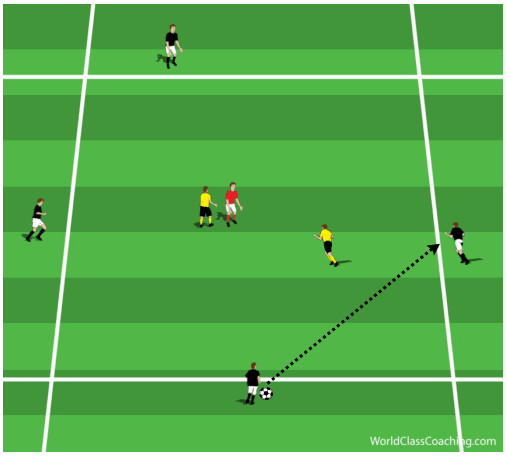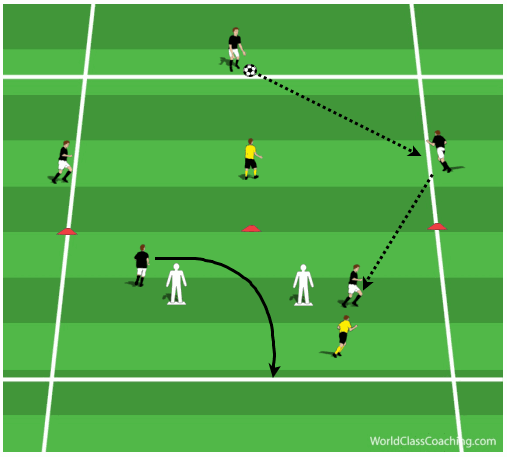By Eric Clermont -
In an earlier article, I highlighted a number of ways where coaches could run a number of practices which could be used to teach players to effectively build out of the back. Many coaches though, do not get past this aspect and wonder why their teams cannot possess the ball higher up the field. The next step is to teach defenders how to possess the ball and find team-mates in the midfield third and to show midfielders some ways to get free and into supporting angles for their team-mates. The following session wil give coaches ideas on this aspect.
Warm-Up
Organization
Start with a 4 v 2 rondo. Develop to 5 v 3 with one attacker playing inside the box. The objective of the attackers is to move the ball quickly enough to knock the ball in the middle off the cone for a point. Defenders are not allowed inside the triangle area. High intensity for 2 mins and then switch 2/3 defenders in the middle. Active Recovery- dynamic stretches.
Coaching Points
- Angles of support
- First touch which is positive and away from pressure
- Movement from the central midfielder- try to move away and then check towards. Attempt to find space behind the defenders (blind side)
- Speed of play

Small-Sided Game
Organization
3 v 1- 2 v 1 with poles. Play starts with a 3 v 1 rondo, with these players attempting to open up a lane to play to one of the two players in the next grid (2 v 1). The 2 players in the other grid attempt to combine and must stop the ball behind the end line to score a point. The ball restarts from the 3 v 1. Switch defenders after 3 minutes of activity.
Coaching Points
- Technical and tactical decisions of ball movement (based on pressure, support and space)
- Movement and interchange between CM's- one CM checking forward, the other spins in behind
- Passing lanes and supporting angles
- Possession V penetration

Extended Activity
Organization- 9 v 6 phase play game (4-3-2 vs 2-3-1). Possession game to end zone. Numbers can be changed to fit the team’s formation or based on the numbers available to practice. The game starts at the top area with a 4 v 1 (3 outside and 1 inside) and this group must play into the next grid (3 v 3). One forward player from the first grid can move into the next grid through the dribble/pass. In the 3 v 3, they must attempt to hit the one striker in the bottom grid (1 v 2) and this attacker can join this player to go 2 v 2. They must play in behind this zone into an end zone or a target player at the bottom.
Coaching Points
- Complimentary movement from midfielders. Attempt to create space for team-mates and each other when possible
- Decision to penetrate or possess the ball from defensive line (4 v 1)
- Supporting angle when entering another zone- try to enter at an angle to give instant support for a give-and-go for the player receiving the ball (who will likely be under pressure)
By Eric Clermont - NSCAA Premier Diploma, USSF A License Candidate


